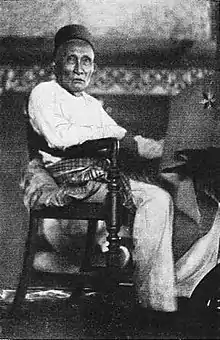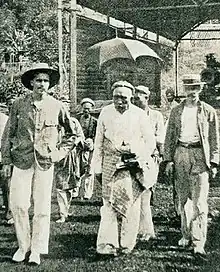Hashim Jalilul Alam Aqamaddin
Hashim Jalilul Alam Aqamaddin (Jawi: هاشم جليل العالم أقام الدين; Malay: Hashim Jalilul Alam Aqamaddin ibni Sultan Omar Ali Saifuddien II; 1825 – 10 May 1906) was the 25th Sultan of Brunei from 1885 to 1906.[1]
| Hashim Jalilul Alam Aqamaddin | |||||
|---|---|---|---|---|---|
 Hashim Jalilul Alam Aqamaddin seated | |||||
| Sultan of Brunei | |||||
| Reign | 30 May 1885 – 10 May 1906 | ||||
| Coronation | 30 May 1895 | ||||
| Predecessor | Abdul Momin | ||||
| Successor | Muhammad Jamalul Alam II | ||||
| Born | Hashim Jalilul Alam Aqamaddin 1825 Istana Kampong Ayer, Brunei Town, Brunei | ||||
| Died | 10 May 1906 (aged 80–81) Istana Kampong Ayer, Brunei Town, Brunei | ||||
| Burial | Kubah Makam Diraja, Brunei Town, Brunei | ||||
| Spouses | Pengiran Chendra Kesuma Pengiran Isteri Pengiran Siti Fatimah | ||||
| Issue | List
| ||||
| |||||
| Father | Omar Ali Saifuddin II | ||||
| Mother | Zaidah Sulaiman | ||||
| Religion | Sunni Islam | ||||
Early life
Hashim Jalilul Alam Aqamaddin was born in 1825 and son to then Sultan Omar Ali Saifuddin II.[2] Before becoming the Sultan, he was one of the four Wazirs (Vizier) in Brunei and was known as Pengiran Temenggong Sahibul Bahar Pengiran Anak Hashim.
Reign (1885-1906)
Upon his ascension to the throne on 29 May 1885, he decided to not to appoint a replacement for his previous position in office of Pengiran Temenggung which left three other Wazirs, thus improving his income and finances.[3]

Dispute over Limbang
He faced a challenge from the British North Borneo Company (BNBC) and the Brooke government (White Rajahs) in Sarawak who wanted more land from Brunei and it was not strong enough to stop the land grabs. In the hopes of improving the relations between the Sultan and the White Rajahs to settle the conflict in Limbang, he leased the settlement of Punang Terusan to Sarawak in 1885.[4] Unfortunately in November of that same year, tensions would rise again in Limbang after the murders of multiple Bruneian Malays. The two alleged culprits were offered to be handed over to the Sultan but later declined as they were not the guilty parties. Due to his decision, the people of Limbang protested and refused to pay their taxes in which was taken advantage of by both the British Consul General Peter Lays and Rajah Charles Brooke. The Sultan eventually agreed to lease Limbang for 6,000 Sarawak dollars per year.[3]
Annexation of Limbang
The British government agreed to the White Rajahs' persuasive thesis in that same year, thus Limbang came into Sarawak's rule after arguing that the Sultan no longer has the ability to govern the colony. In November 1886, Wazirs and people of Bandar Brunei demanded that Limbang to be returned to Brunei with the slogan of "Brunei is the spirit of Limbang and Limbang is the (physical) body of Brunei". The demand was motivated by Abdul Momin's Amanah.[3] In 1887, he wrote to the British Crown with the intention of requesting a British Resident to be put in place. That same year, Padas-Damit was also among the areas annexed.[4] Sultan Hashim made a minor change in Brunei's coinage with the introduction of the copper one cent in 1887.[5]
Treaty of Protection
Not until 17 September 1888, the Sultan signed a Treaty of Protection with Sir Hugh Low of Great Britain in order to prevent further lost of Bruneian territories.[3] The treaty handed the country's foreign affairs over to Great Britain and would only gain more power after the installment of the British Resident in the Supplementary Agreement of 1905/1906.[6] Tho Brunei came under British protectorate, the last territory to be annexed was the Pandaruan District in 1890, with no actions taken by the British.[7]
In 1902, Brooke and Hewett asked him to cede Belait and Tutong to them but he refused and said, "What would happen to me, my chiefs and my descendants? I should be left like a tree, stripped of branches and twigs."[8] They also offered 8,000 Sarawak dollars to the Sultan to lease both Tutong and Belait rivers.[9]
British Resident
Under this treaty, Brunei accepted a British Resident to advise the Sultan on both external and internal affairs except those relating to Islam and Malay customs. The Sultan felt that the British were not upholding their words in the treaty and so he sought help by writing a letter to Sultan Abdul Hamid of Ottoman Turkey.[10] The letter to the Turkish Consul General was discovered letter and confiscated from them by Hewett, the British Resident of the West Coast of Sarawak.[11] Malcolm Stewart Hannibal McArthur was sent to solve the problems in Brunei and began negotiations with the Sultan which finally successfully introduced Residential system to Brunei.[4]
National flag of Brunei
After Brunei signed the Supplementary Agreement of 1905/1906, which made the sultanate a British shade, it was deemed of interest that they should have their own national flag like other countries.[12] Design proposals were made and eventually agreed upon that the design of the flag would be based on the yellow and the irregular colors of white and black. All of these colors have their own symbolic meanings, yellow being the symbol for the Sultan, white being the symbol for the Pengiran Bendahara, and black being the symbol for the Pengiran Pemancha.[13][14]
Death
Hashim died on 10 May 1906,[15] and was buried at the Royal Mausoleum in Bandar Brunei, alongside his father, Omar Ali Saifuddin II.[1] He was succeeded by his eldest surviving son, Pengiran Muda Bongsu Muhammad Jamalul Alam.[15]
Towards the end of his life, Sultan Hashim was 'unwilling to trust any of his chiefs' and depended 'almost exclusively ' upon the help of Edmund Roberts, Manager of the Brunei cutch works and as Director of Public Works in Brunei and Labuan.[16] Till his death, he refused to sanction Limbang and pleaded to the British government to return it back to Brunei.[4]
Personal life
He was married twice and with the notable being Pengiran Isteri Pengiran Siti Fatimah as she gave birth to Hashim's successor Muhammad Jamalul Alam II.[17] Notable issues are:
- Sultan Muhammad Jamalul Alam II, 26th Sultan of Brunei
- Pengiran Anak Khamis, member of the Privy Council[18] and wazir from 1971 to 1975[19]
- Pengiran Anak Safar, member of the Privy Council[18]
Namesakes
- Istana Sultan Hashim Jalilul Alam Aqamaddin, a palace built in Kampong Ayer in the 1880s and was dismantled.[20]
- Kampong Sultan Lama, is a former village in Kampong Ayer and Bandar Seri Begawan.[21]
- Jalan Sultan Hashim, a road named after him in Seria.
References
- Telegram: Reports the death of the Sultan of Brunei. High Commissioner Office, Malaya. 1906. p. 2. Retrieved 25 April 2022 – via Arkib Negara Malaysia.
{{cite book}}: CS1 maint: location missing publisher (link) - Redmond, Christopher (19 December 2016). Lives Beyond Baker Street: A Biographical Dictionary of Sherlock Holmes's Contemporaries. Andrews UK Limited. ISBN 978-1-78092-908-8.
- Gin, Ooi Keat (14 December 2015). Brunei - History, Islam, Society and Contemporary Issues. Routledge. p. 103. ISBN 978-1-317-65998-3.
- Sidhu, Jatswan S. (22 December 2009). Historical Dictionary of Brunei Darussalam. Scarecrow Press. p. 95. ISBN 978-0-8108-7078-9.
- Barrett, William L. S. (1988). Brunei and Nusantara History in Coinage. Brunei History Centre. p. 55.
- "Brunei". CIA World Factbook. 2011. Retrieved 13 January 2011.
- "Translation: From His Highness the Sultan Hashim of Brunei- To A. Keyser, Esq. H. M. Consul for Brunei, 22 Zulkaidah 1316". Cession of the Limbang territory to Sarawak. Forwards letter, from the Sultan of Brunei, regarding- (Archival File). High Commissioner Office, Malaya. 1 March 1899. pp. 6–10. Retrieved 25 April 2022 – via Arkib Negara Malaysia.
{{cite book}}: CS1 maint: location missing publisher (link) - Awang.), Mohd Jamil Al-Sufri (Pehin Orang Kaya Amar Diraja Dato Seri Utama Haji (2008). Melayu Islam Beraja: hakikat dan hasrat (in Malay). Jabatan Pusat Sejarah, Kementerian Kebudayaan, Belia dan Sukan, Negara Brunei Darussalam. ISBN 978-99917-34-63-7.
- Karim, Abdul (2008). Keruntuhan Empayar Brunei KM 19: satu kajian dari sudut ekonomi (in Malay). Pusat Sejarah Brunei, Kementerian Kebudayaan, Belia dan Sukan. p. 153. ISBN 978-99917-34-58-3.
- Awang.), Mohd Jamil Al-Sufri (Pehin Orang Kaya Amar Diraja Dato Seri Utama Haji (2000). History of Brunei in Brief. Brunei History Centre, Ministry of Culture, Youth and Sports. p. 36. ISBN 978-99917-34-11-8.
- al-Sufri, Haji Awang Mohd Jamil (1998). Brunei Darussalam, the Road to Independence. Brunei History Centre, Ministry of Culture, Youth, and Sports. pp. xxxix.
- Horton, A. V. M. (1984). The British residency in Brunei, 1906-1959. Centre for South-East Asian Studies. p. 15.
- The Flag Bulletin. Flag Research Center. 1984. p. 76.
- The National Geographic Magazine. National Geographic Society. 1935. p. 384.
- Haller-Trost, R. (1994). The Brunei-Malaysia Dispute Over Territorial and Maritime Claims in International Law. IBRU. p. 7. ISBN 978-1-897643-07-5.
- Hussainmiya, B. A. (1995). Sultan Omar Ali Saifuddin III and Britain: The Making of Brunei Darussalam. Oxford University Press, USA. p.74
- Journal of the Malaysian Branch of the Royal Asiatic Society. 1994. p. 55.
- Office, Great Britain Colonial (1962). Brunei. H.M. Stationery Office. pp. 175–176.
- Vienne, Marie-Sybille de (9 March 2015). Brunei: From the Age of Commerce to the 21st Century. NUS Press. p. 252. ISBN 978-9971-69-818-8.
- Transformasi sosial masyarakat perkotaan/bandar Borneo-Kalimantan: Prosiding Konferensi Antarauniversiti di Borneo-Kalimantan ke 2, Kalimantan Barat, Indonesia, 13-15 Ogos 2006 (in Indonesian). Institut Pengajian Asia Timur, Universiti Malaysia Sarawak. 2006. p. 87. ISBN 978-983-9257-70-0.
- "The Origin of Kampung Sultan Lama". The Origin of Kampung Sultan Lama. Retrieved 31 July 2023.
